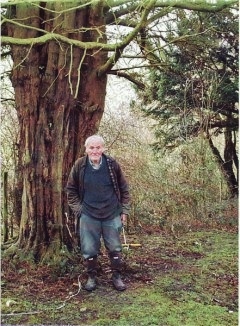The village of Doddington lies 5 miles south-west of Faversham.
| Name | Occupation | Posted from | Until |
|---|---|---|---|
| Sergeant Frederick Elvy | Haulage Contractor F & C Elvy |
25 Jun 1940 | 03 Dec 1944 |
| Private Andrew Stewart Allan | Pig farmer |
18 Jun 1940 | 03 Dec 1944 |
| Private Paul Graham Brenchley | Fruit dealer |
12 Oct 1941 | 03 Dec 1944 |
| Private George Sidney Chesson | Cowman |
08 Jun 1940 | 03 Dec 1944 |
| Private Henry Cuthbert | Farmer |
27 Jun 1940 | 06 May 1943 |
| Private Albert William Gammon | Butcher |
15 Dec 1941 | 03 Dec 1944 |
| Private George Herbert Godden | Fruit dealer |
14 May 1941 | 03 Dec 1944 |
The OB was a shallow four-chambered chalk well beneath a large yew tree on the north side of Great Bradfield Wood, Eastling, at the junction of two woodland rides. The roots were cut with a razor blade, the lid to the bunker placed beneath and the roots perfectly shaped and re-joined so the roots and lid would move as one. There was food and water for two - three weeks, plus ammunition.
Henry Cuthbert: “We spent one weekend every month in the hole. We would talk, play cards, check our equipment and eat; but nothing smelly, like onions. No-one ever found our OB. Later on the OB was linked up to three field telephones used to report activity from OPs. In 1976 the chalkwell was almost full of domestic rubbish but one of the chambers still had rusting remains of bunks, ammunition boxes and barbed wire.
Anyone wanting to enter the OB had to find a marble hidden in the leaves nearby, drop the marble down a mouse hole, which was really a 12 inch pipe, into a tin can. This would be the signal for the men below to open the trapdoor hidden in the gnarled ivy-covered roots at the base of the ancient tree."
Doddington Patrol
Henry Cuthbert recalled: “Regular training was held at The Garth and at Sir Thomas Neame’s farm at Macknade, near Faversham, where we used explosives on trees and stumps. I also went to Coleshill for three days. We practiced night movement and stalking, and shooting from the hip at silhouettes, fun-fair style, set up between trees. I was armed with a .45 automatic pistol and a .22 telescoped rifle. I was a very good shot having been brought up with guns.
If the invasion came we were to act individually to attack the enemy. We expected to get caught and killed and we saw no future. We expected to last two weeks maximum. There would have been vast numbers of German troops. We were not meant to confront the enemy, but if they got in the way then to knife or shoot them. We expected to get caught, but we were doing our duty and sacrifices needed to be made".
TNA ref WO199/3391 and WO199/3390
Hancock data held at B.R.A
Phil Evans
Henry Cuthbert via Adrian Westwood
